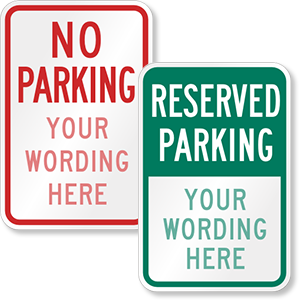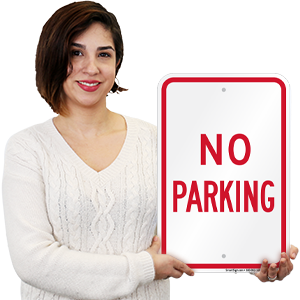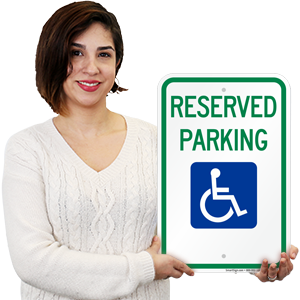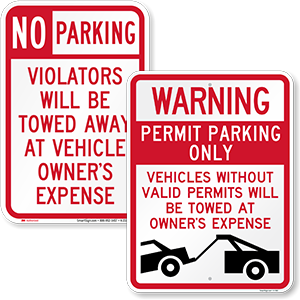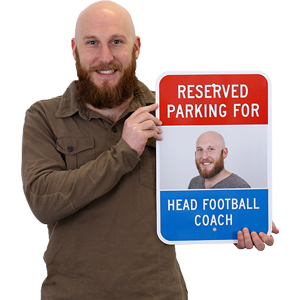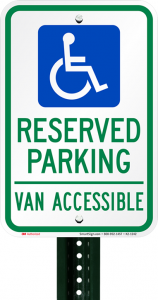Accessible parking: Frequently Asked Questions
Commercial/retail parking
Can a handicapped parking space be “Sundays Only,” or does it have to be permanently reserved for people with disabilities?
Accessible spots must be permanently reserved, but there are other ways of reserving specific spaces for certain use. “It is legal for a business to have a ‘reserved’ spot for an employee or for certain types of customers. For example, some restaurants have signage ‘reserving’ parking spaces for older customers, and the hardware stores have signs for spaces for members of the military or for veterans,” explains John Dineen.
Enforcing the signs, however, is another problem. “While I don’t believe that either type of space would be enforced by the city police, since these categories of shoppers are not protected by the Americans with Disabilities Act or other laws, these signs have some effectiveness,” Dineen says.
“In a similar manner, a business could create a parking space (or spaces) in their parking lot reserved on Sunday for an individual or customers that follow accessible parking size requirements,” he continues. “I’d recommend against the space being reserved with a sign specifically for ‘People with Disabilities’ (without the official accessible parking striping and signage), since that would be confusing both to shoppers and to the police who might enforce parking laws. Perhaps a sign indicating that the space is restricted on Sunday for, say, older customers would create the desired effect.”
Source: John Dineen, Training and Information Specialist, Northwest ADA Center.
I was traveling out-of-state and I put my valid handicapped placard in my rental car, but I still got a ticket. Why don’t some other states recognize my placard? Which ones do?
Most areas do offer reciprocity, but not all. Next time you travel, check with your state’s DMV and the DMV of the state you’ll be visiting to determine whether you’ll need additional identification.
One example: New York City doesn’t recognize New Jersey placards/plates. New Jersey, however, recognizes vehicles with special license plates, placards or parking permits issued by any other region in the U.S. or Canada.
Even if another state recognizes your placard or plates, you aren’t guaranteed free metered, lot, or any other type of parking, which may be why you received the ticket. Fines and fees for parking illegally, not paying a meter, or using improper or lacking identification all vary by jurisdiction.
Can I sue property owners who don’t provide disabled parking spaces?
Possibly, depending on the type of property in question and where it is located.
The Americans with Disabilities Act (ADA) necessitates that certain “facilities” that are open to the public address the needs of all customers; that includes accessible parking. Those facilities include but are not limited to: restaurants, hotels, motels, theaters, doctors’ offices, pharmacies, retail stores, museums, libraries, parks, schools, apartment complexes and daycare centers.
Generally, people seeking to sue have a few choices, depending on the nature and location of their case. Possible remedies include:
- Filing a complaint with the U.S. Attorney’s office or the Department of Justice;
- Filing a lawsuit at a U.S. district court; or, depending on their state of residence
- Hiring an attorney and filing a disability discrimination lawsuit.
Note that the vast majority of ADA-related discrimination lawsuits – an estimated 42% – have been filed in California
Source:
ADA who can I use
Mercury news
Street parking is free to people with disabled placards in my city. Are parking garages allowed to charge me for parking if I have a placard?
Yes, they are allowed to charge for parking.
Garage parking is not necessarily free to those holding accessible parking placards, even in areas that offer gratis street or metered parking. Laws vary by location.
Take Seattle, Washington, for instance: Those with accessible parking permits are provided with free street parking, but do not have access to free parking in private parking garages and facilities. (This even applies to City-owned facilities.)
Another example: The city of Berkeley, California offers a free garage parking program in city garages to disabled drivers who register with the program.
New York State offers a metered parking waiver, which requires an application along with a doctor’s certification, to certain people with severe disabilities.
In Florida, drivers holding the proper permit or special license plate are provided with free parking on public streets and highways in areas used for public parking, and are also allowed to park for free up to four hours in metered parking spaces (unless more time is allowed by a local ordinance). Yet certain areas in Florida are allowed to charge parking fees for those holding an accessible parking placard, including convention centers, cruise port terminals, stadiums, and other facilities that “provide timed parking spaces.” Check in with your state’s DMV for further information.
Source: Seattle.gov
Florida highway safety and motor vehicles
City of Berkeley transporation
Parking lot design and signage
Are the fines the same for parking in the access aisle as for parking in the disabled space?
Not necessarily, as fines vary by jurisdiction.
First, let’s clarify what an access aisle is: The ADA defines the access aisle as a 60-inch-wide (or larger) area “located adjacent to the designated parking space… just wide enough to permit a person using a wheelchair to enter or exit the car.”
Penalties for illegally parking in the accessible space and the access aisle depend on your location. In New York, for example, those who illegally park in either an accessible parking space or the access aisle are subject to the same fee range: fines from $50 to $75 for the first offense, and $75 to $150 for the second offense. (Plus, additional locality-imposed fines may apply, and police may tow the offending vehicle.)
In New Hampshire, on the other hand, violators face a $250 fine for parking in an accessible space. Yet the fine for parking in an access aisle in New Hampshire is $50 – and this also applies to those vehicles bearing an accessible parking placard.
In Florida, even those possessing accessible parking permits are subject to a fine for parking in access aisles – usually $255, though it can vary by municipality. Consult your state’s DMV for specifics.
Source: ADA.gov
New York DMV
Florida highway safety and motor vechicles
Can fire lanes double as access aisles for disabled parking spaces?
That is a tricky question, as there is no clear-cut ADA reference that covers this scenario, and fire lane placement is largely determined by city or jurisdiction.
However, as John Dineen says, “I very much doubt that this would be acceptable. Any traffic flow that used the access aisle – for any reason – would present a significant danger. And if emergency vehicles could travel across the access aisle, then they might need to park in it, which would potentially make the individual’s vehicle inaccessible in an emergency.”
There are, however, definitive standards under the ADA for access aisle design and placement that must be met. For one, the 2010 standards specify that access aisles “not overlap the vehicular way. Access aisles shall be permitted to be placed on either side of the parking space except for angled van parking spaces, which shall have access aisles located on the passenger side of the parking spaces.” Learn more about access aisle design online using the ADA Design Guide.
Source: John Dineen, Training and Information Specialist, Northwest ADA Center
Do the ADA parking regulations apply to bicycle parking?
There are no specific ADA standards for bicycle parking.
Source: Dave Yanchulis, U.S. Access Board
Is a dirt parking lot out of compliance with the ADA, assuming there’s a valid sign for the accessible space?
It’s possible, but not very likely that a dirt parking lot would meet ADA compliance standards. ADA-compliant surfaces are defined as being “stable, firm, and slip resistant,” and must also be marked with an appropriate sign. While a dirt parking lot that has been compacted and treated may fit the standards, it is unlikely.
Can I be ticketed for parking in a handicapped space if the sign is missing and the blue-and-white markings are faded?
All accessible parking spots, regardless of the state in which they are located, must have an appropriate sign designating them as accessible, according to ADA guidelines.
At the same time, the enforcement of accessible parking regulations – such as ticketing those who illegally park in accessible spaces – is handled by local or state authorities. Ticketing tendencies will vary by locale.
In Florida, for example, an accessible parking spot must have a sign and must be “clearly distinguishable as a designated accessible parking.” If there is no above-grade sign noting that the space is accessible, drivers illegally parked there should, according to state law, only receive a warning, not a ticket.
In other areas, you may receive a ticket and/or a fine. If you’ve been ticketed for using a spot without an appropriate sign, take clear photos of the area that show the lack of signage, and consult local laws on how to contest the ticket. In the meantime, consider avoiding parking spots with missing signage.
Source:
ADA national network
The Florida Senate
ExpertLaw forum
At what point in the construction of a new parking lot does accessible parking need to be completed?
The accessible parking spaces should be complete when the parking lot itself is completed. “Under the ADA Standards, when the project is completed, the accessible parking spaces must be completed as well,” says Dave Yanchulis of the U.S. Access Board, a federal agency that promotes equality via accessible design and accessibility standards
“The accessible spaces must be there when construction of the parking lot is completed. You can’t build a parking lot and then say, ‘In Phase 2, we’re going to add the accessible spaces.’ The accessible spaces would have to be part of the parking lot when the project is completed.”
Source: Dave Yanchulis, U.S. Access Board
What kinds of businesses have higher required minimums for disabled parking?
The ADA standards require a higher number of accessible parking spaces in two scenarios: First, hospital outpatient facilities must have a minimum of 10 percent accessible parking (as opposed to the usual requirements, which are determined on a sliding scale).
Secondly, at rehabilitation facilities and outpatient physical therapy facilities that treat certain conditions affecting mobility, there is a minimum of 20 percent accessible parking. Such conditions include those “requiring the use or assistance of a brace, cane, crutch, prosthetic device, wheelchair, or powered mobility aid; arthritic, neurological, or orthopedic conditions that severely limit one’s ability to walk; respiratory diseases and other conditions which may require the use of portable oxygen; and cardiac conditions that impose significant functional limitations.”
Learn more about accessible parking space minimums online here.
Source: U.S. Access Board
What are the requirements for van-accessible spots?
Van accessible spaces have the same requirements as ordinary accessible parking spaces, except that they require 96″ access aisles for wheelchair lifts and higher vertical clearances to accommodate vans. One of every eight accessible parking spaces must be van accessible; under all circumstances, there should be at least one. They also need a van accessible sign.
School/university parking
Can a friend or family member park in an accessible spot, if they are picking up someone with a valid disabled parking placard in the car?
Yes. The disabled parking placard may be issued to the individual with the disability, but the designation is for the vehicle. Provided that he or she shows the disability placard or disability license plate and is traveling with or to pick up the person to whom the placard or plates are issued, a friend or family member should be able to park the placard-or-plate-bearing vehicle in an accessible spot.
There may be hefty penalties or other fines for placard abuse. For example, Massachusetts’ Department of Motor Vehicles explains its law: “The placard is for the disabled person’s benefit only and only for the times that person is a) in the vehicle or b) being dropped off or picked up. Do not let anyone else use your disabled placard parking privileges. If you abuse your disabled placard, or if you allow someone else to do so, one or both of you may be fined $500 – $1,000, face a 30-day license suspension, and lose the disabled parking privileges.”
Consult your state’s DMV for specific regulations in your area.
Source:
Richard Allegra, Association on Higher Education and Disability, DMV
Oregon.gov
Massachusetts RMV.
Can a university fine me for not having a university permit, if I’m displaying a state-issued disabled parking placard? Am I required to pay for a permit?
Yes. It is your responsibility to have the state-issued placard or plates, as well as to meet the university’s own parking guidelines.
Explains Tracie DeFreitas: “If, as a university employee, the employee is parking in a university permit-required lot, then that employee can be required to purchase a parking permit, just like anyone else who is required to have a permit for that lot (unless university policy dictates otherwise). Under the ADA, an employer (or state or city) is not required to provide free parking simply because an employee has a state-issued placard. Also, an employer is not necessarily required to allow an employee to park in an accessible space in a lot that is intended for the public or customers simply because they have a state-issued placard.”
Bear in mind that employers are permitted to determine where employees can park for work-related purposes. “If an employee requires accessible parking, this is a matter of reasonable accommodation that should be addressed with the employer, if there are not accessible spaces already designated in the employee parking area,” says DeFreitas.
Students may also be required to obtain university-specific accessible parking passes in addition to their state-issued ADA placards or plates.
Penn State University, for instance, says that “students possessing a current Person with Disability Registration Plate or Parking Placard must also display a base student Penn State permit and a core area upgrade permit.” In Penn State’s case, “rates are based on lot value and a student will have to pay the difference between their student permit and the lot value if the lot value is greater than the student permit value.”
If all ADA parking spots in a given lot are taken, a car equipped with the appropriate school permit and state-issued ADA plates or placards is permitted to park in regular spaces that aren’t restricted by signs or meters at Penn State.
Students should contact their universities’ health services department to obtain any necessary passes and to address policy questions on school-imposed fees and restrictions.
Source: Tracie DeFreitas, M.S., Lead Consultant & ADA Specialist for the Job Accommodation Network (JAN), a service of the U.S. Department of Labor, Office of Disability Employment Policy
Penn State Transportation
Residential parking
What should the maximum number of accessible parking spaces be if a residential facility has more disabled tenants than the minimum number of spaces?
There is no maximum accessible parking requirement under the ADA. In fact, aside from common areas such as the residential facility’s lobby, for the most part, ADA regulations do not provide guidelines for residential facilities.
Although the ADA does not cover residential private apartments and houses, if a doctor’s office, day care center, or other “place of public accommodation” is located in a private residence, then the part of the residence used publically is subject to ADA rules.
Residential facilities are guided by Fair Housing Act (FHA) requirements, which stipulate that, at minimum, 2% of the total parking spaces must be accessible and are required to be located on an accessible route. If a buyer or renter asks for an accessible space when first buying or renting a residence, explains the FHA, “it may be necessary to provide additional accessible parking spaces if the 2% are already reserved.”
Furthermore, the accessible spaces are required to be provided on the “same terms and with the full range of choices offered to others. If the buildings have already been constructed and further accessible parking is needed to reasonably accommodate a person with a disability, “additional accessible parking spaces may be required,” according to the FHA.
Read more about the Fair Housing Accessibility Guidelines online here.
Source:
Fair Housing First
ADA
In a condo complex, can tenants’ assigned parking spaces be converted to disabled parking spots?
Yes, they can, explains John Dineen: “We recommend, however, that those parking spaces be marked with the ‘Reserved for John Smith’ sign rather than marked with the accessible striping and signage. Since anyone with the appropriate placard can park in an accessible space, there is no guarantee that the resident will get to use that spot.”
Residents can make requests for reasonable accommodations, such as requesting an assigned disability parking space, under the Fair Housing Act (FHA).
Keep in mind that, according to the ADA, residential facilities where parking spaces are assigned to specific apartments need not post signs for accessible spaces, though they do need to meet all other ADA guidelines.
Source: John Dineen, Training and Information Specialist, Northwest ADA Center, ADA
If tenants have assigned parking, how should the condo association add access lanes to preexisting spots if they need to create more disabled parking than they already have?
Depending on the needs of residents, space used for non-accessible spots may need to be used to create additional access lanes. But keep in mind that residents will usually have varied needs, and not everyone may require a wider parking space plus an access aisle.
John Dineen explains one potential scenario: “Someone with a heart condition might need a parking space as close as possible to the elevator, but will not need the additional parking space room.”
“However, when the resident does need the additional space – such as someone who uses a wheelchair or has a van with a lift – then restriping is needed. The cost of doing the restriping cannot be passed on to the resident with the disability. And obviously, accessible parking spaces tend to be located in the same area, so three parking spaces may become two accessible parking spaces, and the restriping is minimal,” says Dineen.
Dineen recommends checking out the Department of Justice and Fair Housing Administration’s discussion on how landlords can honor reasonable accommodations for residents with disabilities: Reasonable Accommodations Under the Fair Housing Act. “The fact that someone may lose a parking space in the apartment or condo parking lot tends to carry less weight than being unable to create an accessible parking space,” he explains, “Though each situation has its individual characteristics that may need to be considered.”
The building may need to reduce non-accessible parking spots in order to free up space for implementing access lanes or expanding accessible parking options.
Have further questions about tenant accommodations? Contact your state’s Fair Housing office, or reach out to the U.S. Department of Housing and Urban Development.
Are landlords required to create access aisles and ramps as well as putting up a sign?
At least 2% of all residential parking spaces must be designated as accessible – and this includes access aisles and signage – under the Fair Housing Act.
Residential parking must also have an accessible route, which under the FHA’s accessibility guidelines means a “continuous unobstructed path connecting accessible elements and spaces in a building or within a site that can be negotiated by a person with a severe disability using a wheelchair.”
Exterior accessible routes may include parking access aisles, curb ramps, walks, ramps and lifts. The accessible route should also be safe and usable for those with other disabilities. (For example, curb ramps, which are transitions between parking areas, roads, sidewalks and access areas, may be beneficial for those using wheelchairs or other mobility aids, but can pose a danger to those who are blind or who “use the curb as a ‘cue’ to know when they are entering the street.”)
Landlords are also required to provide “reasonable accommodations” under the Fair Housing Act. What’s a reasonable accommodation? The Department of Housing and Urban Development (HUD) defines it as “a change, adaptation or modification to a policy, program, service, or workplace which will allow a qualified person with a disability to participate fully in a program, take advantage of a service, or perform a job.”
So, depending on the case and the financial burden involved, landlords may be required to grant or to “allow persons with disabilities to make reasonable modifications,” which might include the installation of a ramp or other aid.
Learn more about FHA and HUD stipulations online.
Source:
Fair Housing Accessibility Guidelines
Accessible and Usable Public and Common Use Areas
Disability Rights in Housing
ADA Guidelines for Apartments
Can an apartment complex assign accessible parking spaces? Are they required to provide extra, un-assigned parking spaces for visitors?
According to the Fair Housing Act (FHA), at least 2% of the parking spaces offered for residents must be designated as accessible parking spaces, and these must have access aisles and signage.
Under the FHA, building owners must also provide “reasonable accommodations” for tenants and/or owners who have disabilities. Jennifer Perry of the Northeast ADA Center, explains: “It is not uncommon for residents to request accessible and/or ‘reserved’ accessible parking spaces closer to their unit entrance if needed as a reasonable accommodation due to disability.”
In cases where there is also on-site visitor parking, such as a leasing office or another area that is also open to the public, “then that specific parking area is likely required to comply with the ADA and provide the required number of accessible parking spaces based on the total number of parking spaces provided for visitors.”
Ultimately, FHA requirements are enforced by the U.S. Department of Housing and Urban Development (HUD). Learn more about the FHA design and construction requirements, online at Fair Housing Accessibility FIRST, the HUD website that provides technical assistance and enforcement information about the Fair Housing Act.
Statutes vary, too, explains Robert H. Fitz, Jr., PLA, ASLA Principal at Koontz-Bryant, P.C. Site Development Solutions. “Typically, any person with a valid plate or placard can park in any space identified as being reserved for use by persons with disabilities whether on public property or private property available for public use regardless whether or not it has been ‘assigned.’ It also depends on whether or not there are extra accessible spaces provided. Eliminating the availability of an accessible parking required by the Fair Housing Act violates the law.”
(Note that the Northeast ADA Center is not involved in the enforcement of the ADA and does not provide legal advice.)
Source: Jennifer Perry Access Specialist, Northeast ADA Center Robert Fitz [email protected]
Can an apartment complex remove signage in an accessible spot if there isn’t enough demand for it?
That depends on how much accessible parking is provided on the property. Explains Robert H. Fitz, “[Removing signage is an option] only if there is still sufficient accessible parking on the property per the Americans with Disabilities Act. Local jurisdictional approval may be required because doing so would alter an approved site plan.”
Source: Robert Fitz Jr., PLA, ASLA Principal at Koontz-Bryant, P.C. Site Development Solutions
Can the landlord remove an accessible parking space when a disabled tenant moves out?
Yes, but under the FHA, the building must still maintain at least 2% of the total resident parking spaces as accessible spaces. “If a tenant requested a reserved or accessible parking space as an accommodation to their disability and then moves out, the accommodation is no longer necessary and the space could be removed,” explains Jennifer Perry.
Perry continues, “…The Fair Housing Act still requires that at least 2% of the resident parking spaces provided remain accessible at all times, so if a landlord removes any accessible parking spaces when a tenant vacates, they must also ensure that they have ‘on hand’ 2% of the spaces for residents designated as accessible spaces.”
Check out Chapter 2 of the Fair Housing Act Design Manual for further info.
(The Northeast ADA Center is not involved in the enforcement of the ADA and does not provide legal advice.)
Source:Jennifer Perry Access Specialist, Northeast ADA Center
Employee parking
In a parking lot shared by several businesses, how should accessible parking be split up?
Under the ADA, the number of accessible parking spots is determined by total number of parking spots in the individual lot itself, not by, for example, the businesses sharing it.
The ADA does not provide guidance on how to split these spots up, but it does offer guidelines on accessible spot placement. The accessible parking spaces “must be located on the shortest accessible route of travel to an accessible facility entrance.”
Ask yourself: Are there multiple accessible entrances to the businesses with adjacent parking? If so, the accessible spots “must be dispersed and located closest to the accessible entrances.”
Furthermore, these accessible spots “may be clustered in one or more lots if equivalent or greater accessibility is provided in terms of distance from the accessible entrance, parking fees, and convenience.”
Businesses that don’t provide any parking are usually exempt from meeting the accessible parking spot minimum, but those that “contract with third parties to provide parking to their customers or employees, and the third‐party operators of parking facilities generally are responsible to provide accessible parking under the ADA,” according to the Northwest ADA Center.
Source:
ADA
How to Comply With the Americans With Disabilities Act
In a shared lot, can each business be allocated a fraction of the total accessible parking spots, for example by posting a sign that says “PARKING FOR [BUSINESS NAME] ONLY?”
You’d have to consult your local zoning codes, which usually govern parking space distribution among businesses in shared lots, as this particular scenario isn’t covered by the ADA.
Regardless of local laws, the ADA does require that, in shared parking lots, accessible spaces should be dispersed to effectively serve multiple entrances (if there are multiple entrances).
Source: Jennifer Perry, Northeast ADA Center
Can employees be assigned accessible parking, or is it first-come, first-served?
Yes, employees can be assigned accessible parking. But keep in mind that, as the ADA states, parking lots with “assigned or leased spaces are not exempt from the requirement for accessible parking.”
Businesses with an existing first-come, first-served parking policy may need to adjust that policy to better accommodate the needs of certain employees. One option: The employer may continue to assign parking spots to specific employees, designating accessible spots to those employees who require them
ADA design standards and requirements for minimum accessible spaces for the lot must still be met.
If the employer provides parking to all staff, then providing accessible, reserved parking may be considered a part of employers’ reasonable accommodation of employees with disabilities.
Even if parking is not provided as an employment benefit, however, it may “still be a reasonable accommodation if an employee is otherwise unable to access the work site and providing the parking (or other accommodation) would not impose an undue burden on the employer,” notes the Northwest ADA Center.
Job Accommodation Network
ADA
Can a property owner tell us how many disabled spots our employees are allowed to use, or are these parking spaces first-come, first-served?
The landlord and the tenant of the business are both responsible for meeting ADA standards, though they can decide who is responsible for meeting ADA guidelines via the lease or contract.
“If an employer is leasing parking spaces and has some control over the spaces available, then the employer should be able to dictate how those spaces will be used. However, this may depend on the leasing contract. The lot should include the minimum number of accessible spaces per the ADA Accessibility Guidelines, as a start,” explains Tracie DeFreitas. “If the employer has no control over the parking (i.e., it’s a private lot), then they will not have the ability to dictate how the spaces are designated or used. Employees would be parking at their own will in this scenario.”
Tracie DeFreitas, Lead Consultant & ADA Specialist for the Job Accommodation Network (JAN), a service of the U.S. Department of Labor, Office of Disability Employment Policy. How to Comply With the Americans With Disabilities Act
My employee parking lot is far from the building, and we’re transported by shuttle. Where must the shuttle drop me off if I have a disability?
There is no one-size-fits-all standard in this scenario, nor a specific answer found in the ADA guidelines. The logical answer is that you should contact your employer to arrange reasonable accommodations; request to be dropped off at the most accessible location available.
“It would make sense that the shuttle would drop employees off at the most accessible location for entering the place of employment,” explains Tracie DeFreitas. “If an employee has specific accessibility needs, this should be addressed with the employer as an accommodation issue in order to determine the most accessible path of travel for the employee. This should be handled on a case-by-case basis.”
Tracie DeFreitas, , M.S., Lead Consultant & ADA Specialist for the Job Accommodation Network (JAN), a service of the U.S. Department of Labor, Office of Disability Employment Policy.
Can employees with disabled parking permits use a retail or visitors’ parking lot, or is the employer required to provide a separate parking area with accessible spots?
It depends. Do other employees receive employer-provided parking as a benefit? If an employer offers parking as an employment benefit to all employees, under the ADA it may also be required to provide parking for employees with disabilities, unless such a requirement would inflict undue hardship.
Employers must offer “reasonable accommodations that enable employees with disabilities to enjoy equal benefits of employment,” and that can include parking.
One exception: if an employer provides a specific group with employee parking as a perk, such as upper management employees, it may not necessarily be required to provide parking to non-upper management employees who would require accessible parking.
The ADA does not offer specific guidance for those employers who do not provide any employee parking.
Source:
Job Accommodation Network
A note on language
We strongly favor the use of language that refers to types of parking rather than terms
that generalize about the people who use it. For that reason, in our answers, we will use terms such as “accessible parking” and “accessible parking placard” rather than the unfortunately much more common “handicapped parking” and “disabled parking.”
At the same time, the general public’s language may not always use the preferred terms, and these questions are adapted from questions we have gotten from them. Interviewees quoted in answers here may sometimes use “disabled” as well.
We commit ourselves to discussing accessibility in terms of adaptation to the diverse needs of the public and encourage others to do likewise.

